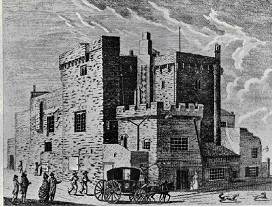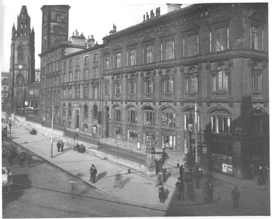
As far back as 1252 there has been a townhouse on the Liverpool shore. Sir John Stanley pulled down the old house in 1406 and built the first Tower known as the Tower of Liverpool. This was used as an embarkation base for their property in the Isle of Man. The Tower stood at the shore end of Water Street.
Water street being one of the original seven streets of Liverpool was originally called ‘Bonke Street’. ‘Bonke’ was Lancashire dialect for ‘bank’ (taken from river bank). Through the years it became Bank Street and then eventually Water Street in 1520’s.
During the 18th century the Tower of Liverpool, between Tower gardens and Stringers alley was the Jail of Liverpool. A large arch joined the Tower to the building on the other side of Tower Gardens and this building was used to house debtors and Criminals.
The Tower had 7 small underground dungeons, each approx 6’ sq. There were between 3-5 prisoners per dungeon, hence “ jail fever” was prevalent. A room at the Tower was used as a Chapel which later became the Debtors Room.
In 1756 during the war with France the Tower was also used to confine prisoners of war.
The Tower became the property of the corporation in 1775 when it purchased it for £1535 10s from the then owner Sir Richard Clayton.
The Tower ceased being a jail on 3rd July 1811 when all the criminals were moved to the new jail in Great Howard Street. In 1877 two men convicted of robbery were executed in Water Street opposite the Old Tower.
By the end of the 18th century the Tower was in disrepair and was pulled down in 1819 to be replaced by warehouses.

In 1856 the warehouses gave way to the second Tower called Tower Buildings, a large Italianate office block by J. A. Picton. Unfortunately The Tower fell foul to the demands of commerce and was demolished in the early 20th century.
The present Tower Building, designed by Walter Aubrey Thomas was completed around 1908. Walter Aubrey Thomas is not to be confused with his contemporary, Walter W. Thomas, who designed the Philharmonic Dining Rooms , ‘The Phil’ and The Vines, ‘The Big House’. It was possibly to avoid confusion that he always styled himself as W. Aubrey Thomas
During the air raids over Liverpool in 1941 Tower Building was badly bombed and several people were killed and injured. Check out the BBC site for the real life story.
‘WW2 People’s War is an online archive of wartime memories contributed by members of the public and gathered by the BBC. The archive can be found at www.bbc.co.uk/ww2peopleswar/stories/53/a4074653.shtml
Tower building has over the years seen many different types of businesses establish themselves within its walls, but did you know that Resourceful Chilean Captain Luis Pardo, who rescued Shackleton’s men marooned on distant Elephant Island in August 1916, was based in Tower Building as the Chilean Consul of Liverpool between 1930-1934.
| Acknowledgement
We wish to acknowledge and express our gratitude to The Liverpool Records Office and Liverpool Libraries for granting us permission to display some of the wonderful pictures they hold.Their valuable help and advice assisted greatly in helping us to bring the true history of the building to life. We would also like to thank Brock Carmichael Architects for granting us permission to display some of the photo’s they took during the Tower Building renovations. |

